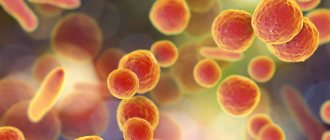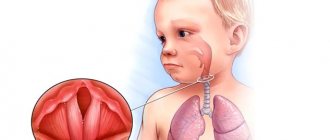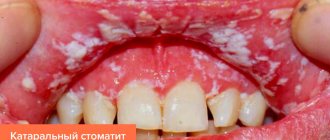Gastroenterologist
Vinogradov
Dmitry Alekseevich
6 years experience
Gastroenterologist
Make an appointment
Crohn's disease is typical for people aged 15-35 years. It affects both sexes equally. There is a hereditary predisposition to the disease. What should be understood by the term “Crohn's disease”? This is a chronic inflammatory disease of the gastrointestinal tract. It affects all layers of the intestinal wall. The pathology is characterized by the presence of nodular formations (granulomas). The disease received its name in honor of the doctor B. Crohn from the USA, who was the first to discover the pathology and describe it.
Etiology
Crohn's disease is a polyetiological disease. Factors that increase the risk of developing this pathology include:
- genetic predisposition: the majority of newly identified patients have a burdened hereditary history along a similar line;
- immune imbalance;
- eating increased amounts of refined foods, as well as simple carbohydrates;
- the presence of other autoimmune problems: rheumatoid arthritis, including juvenile arthritis, systemic lupus erythematosus, etc.;
- smoking.
There is also a theory of the influence of lifestyle on the incidence of CD, according to which in developed countries people are susceptible to pathology more often than in poor countries.
Causes
Crohn's disease (CD) develops when the immune system begins to attack the body's own tissues - the intestines and other digestive organs. However, the exact cause of the disease is unknown. There are several groups of factors that may be involved in the development of the disease:
- hereditary factors (if Crohn's disease is present in family members, the risk of the disease in relatives increases);
- genetic factors (in particular, mutation of the NOD2 gene, responsible for the synthesis of proteins involved in the work of innate immunity);
- infections (the influence of some bacteria and viruses on excessive activation of the immune response is assumed);
- immunological factors (directly, disorders of the immune system).
Additional risk factors may include:
- age (Crohn's disease often manifests itself before 30 years of age);
- excessive intake of non-steroidal anti-inflammatory drugs (NSAIDs), combined oral contraceptives (COCs);
- smoking;
- errors in diet.
Is Crohn's disease contagious?
Crohn's disease occurs due to a malfunction of the immune system. It's not contagious. However, if the disease is present in close relatives, the disease may manifest itself due to a hereditary factor.
Symptoms of the disease
Crohn's disease is characterized by a variety of clinical manifestations. Symptoms depend on the form of the pathology and the nature of the course.
General symptoms
:
- lethargy, fatigue;
- wave-like temperature changes;
- decreased performance;
- anemia.
Clinical symptoms indicating intestinal damage:
- picture of an acute abdomen;
- diarrhea;
- nausea;
- increased gas formation;
- causeless significant weight loss in a short period of time.
Non-intestinal signs depending on the location of the pathological process:
- eye damage: conjunctivitis, uveitis develops;
- localization of the pathological process in the oral cavity: aphthous stomatitis occurs;
- joint damage: monoarthritis is observed;
- involvement of the skin: the appearance of erythema nodosum, angiitis;
- damage to the liver and gallbladder: fatty degeneration develops, as well as cholangitis, cholelithiasis;
- pathological processes in the liver: nephrolithiasis, pyelonephritis, cystitis are observed.
The fistulous form of the disease is characterized by the occurrence of anal fissures, which are characterized by a long regeneration process, as well as the appearance of anal fistulas.
Preparing for a visit and a doctor's visit
A gastroenterologist diagnoses and treats gastrointestinal diseases. Before visiting a specialist, prepare for the fact that you may be asked the following questions:
- the onset of symptoms when ailments manifest themselves for the first time;
- symptoms are present all the time or unpleasant phenomena occur periodically;
- Do the symptoms intensify due to some events, provoking factors (after stressful situations, taking certain medications, certain foods, etc.);
- your general condition - how uncomfortable the manifestations of the disease are, how much your well-being has worsened and how this is manifested, whether your quality of life has decreased, whether there are any restrictions on any type of activity or taking certain foods;
- whether you took medications after the first signs of the disease appeared and whether you are currently taking certain medications (list).
Based on the information received and a comprehensive clinical examination (palpation of the abdomen, examination of the oral cavity), the specialist draws up a subsequent examination regimen.
Classification
The current classification of Crohn's disease has been developed based on the location of the lesion, the nature and severity of the course, the prevalence of the process, as well as the phenotypic form and dependence on the response to hormonal therapy.
Classification by location of the lesion (Montreal):
- terminal yelitis;
- colitis;
- ileocolitis.
The first two forms are characterized by damage to the upper gastrointestinal tract, the latter by the development of a pathological process in the anal area.
According to the prevalence of the lesion:
- clearly localized CD: divided into isolated lesions of a small area of the intestine and lesions no more than 30 cm;
- widespread CD: characterized by a lesion area larger than 100 cm (the sum of all areas is taken into account in the calculation).
According to the nature of the flow:
- acute: the period from the onset of the disease does not exceed 6 months;
- chronic continuous: subject to adequate therapy, there are no six-month periods of remission;
- chronic relapsing course: a history of the disease includes six-month or longer periods of remission.
According to severity:
- light;
- medium-heavy;
- heavy.
Severity is assessed based on the degree of attack, that is, the current exacerbation or the Best activity index. The use of a particular rating system is determined on the basis of the practical methods of a particular medical institution.
Depending on the phenotypic form:
- non-stricturing, non-penetrating (similar names in Russian-language scientific manuals - luminal, uncomplicated, as well as infiltrative-inflammatory);
- stricturing form (stenotic);
- penetrating option (fistula).
Perianal lesions can either complement any of the listed phenotypic forms or be an independent clinical manifestation of CD.
Depending on the response to hormonal therapy:
- Hormonal resistance. In the case of a severe form, the absence of positive dynamics after more than 7 days of active therapy is taken into account, and in the case of a moderate course, within two weeks.
- Hormonal dependence. The status is assigned when a relapse develops within 90 days after hormonal therapy, as well as when the activity of the pathology increases when the dose of drugs is reduced (after stable improvement) for 3 months after the course.
Example of DS formulation: Crohn's disease: ileocolitis, stenotic form (stricture without intestinal obstruction), chronic relapsing course, mild attack. Hormonal dependence.
specialist
Our doctors will answer any questions you may have
Tumasova Anna Valerievna Gastroenterologist
Possible complications
With Crohn's disease, surgical complications quite often develop, which often become the main cause of death. Most often, these are internal fistulas and adhesions, perforation of the intestinal wall, abscess formation, and peritonitis.
The chronic inflammatory process contributes to the active growth of scar connective tissue, which causes a narrowing of the intestinal lumen, causing intestinal obstruction. This condition requires immediate surgical intervention.
When ulcers develop, there is a high probability of bleeding, which will lead to destabilization of the patient and severe hemodynamic disturbances.
Fistulas in the bladder or uterine area can cause infectious processes.
When segments of the small intestine are involved, the risk of malignancy of the process increases, and if pathological processes occur in the large intestine, there is a long-term risk of colorectal cancer.
Chronic malabsorption syndrome leads to nutritional deficiency and disruption of all metabolic processes.
Risk factors
Factors that can worsen Crohn's disease symptoms and lead to complications:
- taking certain medications;
- infections;
- hormonal disorders (more often in women);
- increased stress;
- smoking.
Risk factors for the disease are as follows:
- family history of Crohn's disease. If there are close relatives (mother, father, brothers, sisters), the risk of the disease increases;
- smoking.
Diagnostics
The diagnosis of Crohn's disease is made on the basis of combined anamnestic data, clinical picture and typical changes in endoscopic and histological studies.
The generally accepted criteria for a reliable diagnosis according to Lennard-Jones, which include the following points:
- lesions from the oral cavity to the anal zone of varying severity;
- intermittent nature of the lesion;
- fibrous changes;
- transmural direction of the lesion;
- lymphoid tissue: aphthoid ulcers or lymphoid accumulations;
- mucin: normal content in the area of active inflammation;
- presence of sarcoid granuloma.
A probable diagnosis is considered reliable if the presence of 3 signs is detected, or a granuloma is detected in combination with any other manifestation.
Diagnosis of Crohn's disease involves complex measures, including a consultation with a physical examination, instrumental and laboratory diagnostics.
Physical examination
During physical examination, various manifestations of CD may be detected, for example, fever, infiltration in the abdominal region, nutritional deficiency, extraintestinal clinical symptoms, external intestinal fistulas, etc.
The physical examination should include examination of the perianal area as well as digital examination of the rectum (rectum).
Instrumental diagnostics
It is the preferred method for diagnosing CD. To confirm the diagnosis, the following is carried out:
- overview Rg-graphy of the abdominal region (for signs of intestinal obstruction);
- colonoscopy with ileoscopy;
- sigmoidoscopy
- Ultrasound;
- esophagogastroduodenoscopy;
- fistulography (if external fistulas are detected);
- MRI or CT with contrast of the entire intestine (if impossible, X-ray contrast study with barium suspension is allowed);
- biopsy of the mucous membrane in the affected area.
The diagnosis must be confirmed comprehensively: endoscopically + morphology or Rg. If necessary, capsule endoscopy and balloon enteroscopy may be prescribed.
Endoscopic criteria for CD are: cobblestone symptom, regional (intermittent) lesions, linear ulcers, aphthae, and sometimes fistula structures and orifices.
Radiological criteria: intermittent lesions, cobblestone pattern, strictures, fistulas, abscesses of interintestinal or intra-abdominal origin.
Morphological features: slit-like ulcers, sarcoid granulomas, focal lymphoplasmacytic infiltration, transmural inflammation, intermittent lesions.
- Gastroscopy (FGS, FGDS, EGDS)
- Colonoscopy
- Ultrasound of the intestines
- Magnetic resonance imaging
Laboratory diagnostics
Includes the required clinical minimum:
- UAC;
- biochemical analysis;
- immunogram;
- blood test to determine antibodies in SS;
- advanced stool analysis, including determination of calprotectin levels.
Laboratory boards are non-specific.
- General and biochemical blood test
Differential diagnosis
In most situations, Crohn's disease must be differentiated from pathologies such as:
- ulcerative colitis;
- ischemic colitis;
- acute appendicitis;
- tuberculosis of the intestine;
- acute intestinal infections;
- systemic vasculitis;
- IBS.
Actinomycosis, endometriosis, radiation damage to the intestine, etc. are also subject to differential diagnosis.
Pathogenesis
Crohn's disease develops when, under the influence of various factors (hereditary predisposition and genetic mutations, microbial activity and disorders of the immune system), an inflammatory response from the immune system is activated. The action of the immune system leads to damage to the intestinal wall. At the same time, a distinctive feature of the disease is the occurrence of ulcers affecting the entire thickness of the intestinal wall.
Over time, the intestinal mucosa takes on the characteristic appearance of a “cobblestone pavement” - areas of ulcers and cracks alternate with areas of accumulation of immune cells and swelling of the mucous membrane (Fig. 2).
Figure 2. Cobblestone-like changes in the intestinal mucosa in Crohn's disease. Source: aboutkidshealth ca Source: unspecific. ru.
Crohn's disease in adults
Crohn's disease is considered a disease of the young - it affects mainly middle-aged people, with the peak incidence occurring between 15 and 35 years of age. Among the older age group, a second peak is observed - after 60 years.
At the same time, the disease has a widespread nature of the lesions - unlike other diseases from the IBD group ("inflammatory bowel diseases"), it can affect any part of the digestive tract, from the oral cavity to the rectum (Fig. 3).
Figure 3. Crohn's disease can affect the entire digestive tract. Source: QuIBDO
Crohn's disease, like many others from the group of autoimmune diseases, has a chronic course - one way or another, once it occurs, it will accompany the patient for many years. However, with proper treatment, the symptoms of the disease can often be minimized.
Crohn's disease in children
The onset of Crohn's disease in children occurs on average at 10-15 years of age. Boys are more likely to get sick. Just like in adults, any part of the digestive tract can be affected in children, but most often the disease occurs in the form of ileocolitis, colitis and ileitis.
Treatment of Crohn's disease
Treatment options include drug therapy, surgery, active psychosocial support and specific dietary therapy.
The choice of treatment method depends on the severity of the process, the extent and location of the lesion, the presence of extraintestinal signs and intestinal complications.
The goals of therapy are:
- induction of remission with its subsequent maintenance;
- prevention of complications;
- prevention of surgical intervention;
- in case of progression and development of threatening conditions, timely surgical treatment is required.
But taking into account the fact that surgical methods do not lead to complete recovery, after they are performed, anti-relapse therapy is prescribed no later than 2 weeks from the date of surgery.
Drug therapy
Prescribed medications are conventionally divided into the following groups:
- agents for inducing long-term remission: glucocorticosteroids, tropical drugs, immunosuppressants, biological genetic engineering agents (monoclonal antibodies), antibiotics, salicylates;
- drugs to maintain remission: immunosuppressants, biological products, 5-aminosalicylic acid, including its derivatives;
- symptomatic remedies depending on clinical manifestations.
When prescribing hormonal therapy, a gradual reduction is mandatory; immediate withdrawal is prohibited.
Surgery
The impossibility of a radical cure often leads to surgical intervention - resection, which increases the risk of developing short bowel syndrome.
The tactics of surgical treatment are aimed at performing the most limited resections and performing organ-preserving interventions.
Indications for surgical treatment include complications, failure of conservative treatment, and delayed physical development.
Questions for the doctor
Which doctor should I see?
If you have complaints of abdominal pain, diarrhea, loss of appetite and body weight, or increased body temperature, you should consult a physician or gastroenterologist.
In case of long-term healing of anal fissures, it is advisable to consult a coloproctologist.
When will I get better?
Crohn's disease usually occurs cyclically: periods of disease attack (the onset of disease symptoms to varying degrees) are followed by periods of remission (when inflammation is under control and there are no symptoms of the disease).
There is no clear temporal pattern between these states. Currently, 10 to 20 percent of patients experience long-term remission of the disease after the initial outbreak.
When should I have surgery?
As discussed, medications can help control the symptoms and complications of Crohn's disease and may help you avoid or delay surgery. However, surgery may be recommended if your symptoms are not controlled by medication or if the disease is complicated by surgical pathology (outlined in the section "Complications of disease").
Surgery (or drug therapy) does not cure Crohn's disease, but it can help you feel better and return to normal activities. The disease eventually returns after surgery; most people will need to continue taking medications to control symptoms long-term. However, 85 to 90 percent of people have no symptoms of the disease for a year after surgery. Up to 20 percent of people have no symptoms 15 years after surgery.
What should I avoid?
1) Don't smoke. Smoking worsens symptoms and increases the risk of complications.
2) Avoid using non-steroidal anti-inflammatory drugs (such as Paracetamol, Aspirin, Ibuprofen). Take them only for strict indications and after the advice of a doctor.
3) Do not be afraid of consuming foods with gluten or dairy products - there is no clear evidence that they are harmful to health in this disease.
Prevention and follow-up
Since the causes of the development of the disease are multi-etiological, there is no unified prevention scheme. Patients are shown active psychosocial support, it is recommended to avoid stressful situations, overexertion, and follow a diet that alleviates the patient’s condition and reduces the intensity of symptoms.
General dietary recommendations:
- reducing consumption of dairy products;
- priority in consuming foods with a low fat index;
- restriction in the diet of foods that are rich in fiber;
- switching to fractional meals (frequent meals, but in small portions);
- refusal of alcohol, tea and coffee drinks, as well as spices;
- sufficient water intake.
In addition to diet, patients are strongly advised to quit smoking completely.
Dispensary observation
The regularity and volume of DO is determined individually, but for most patients the following is indicated:
- once every 3 months, perform a stool test for calprotectin;
- take the OAC at least once every 3 months;
- undergo an ultrasound scan of the intestines every six months;
- Perform an MRI of the intestines annually.
Once a year, it is recommended to undergo a local examination of the perianal area and a digital rectal examination.
List of sources used
- Gastroenterology. National leadership /2019.-708 p.
- Belousova E.A. Recommendations for the diagnosis and treatment of Crohn's disease. Pharmateka. 2009. No. 13. pp. 38-44.
- American College of Gastroenterology
- Lennard-Jones JE Classification of inflammatory bowel disease. Scand. J. Gastroenterol. Suppl. - 1989;170:2-6.
- Tertychny A.S., Andreev A.I., Geboes K. Modern approaches to the morphological diagnosis of inflammatory bowel diseases based on endoscopic biopsies. Archives of pathology. - 2011. - t.73. - No1. — p.40-47.
- Vorobyov G.I., Orlova L.P., Samsonova T.V., Kapuller L.L., Mikhailova T.L., Khalif I.L. Possibilities of ultrasound examination in the diagnosis of Crohn's disease. Ultrasound and functional diagnostics. - 2010. - No. 1. - pp. 29-36.
When to see a doctor
The symptoms of Crohn's ulcer disease are similar to many other pathologies. To diagnose it, you need a comprehensive, comprehensive examination. The disease is most often diagnosed by a specialist such as a gastroenterologist.
You should consult a doctor if the following phenomena occur:
- frequent diarrhea that does not go away;
- incessant pain in the gastrointestinal tract;
- rapid weight loss without objective reasons;
- traces of blood in the stool.
In all these cases, you must make an appointment with a gastroenterologist. A gastroenterologist will conduct an in-depth diagnosis of the disease, prescribe treatment, and, if necessary, give a referral for consultation to other specialists.
A general examination will also be carried out, laboratory and instrumental tests will be prescribed. In difficult cases, doctors of other specializations may be involved. For example, you may need to consult an infectious disease specialist, surgeon or coloproctologist. All these and many other specialists work at JSC “Medicine” (clinic of academician Roitberg).










